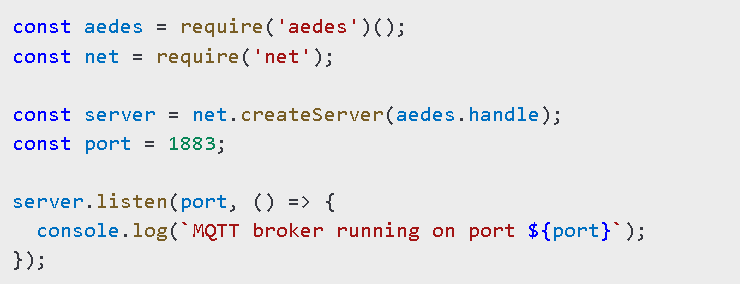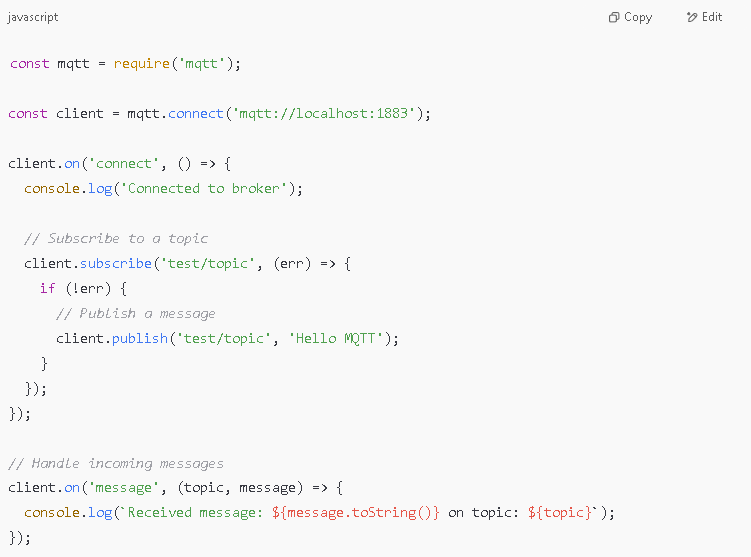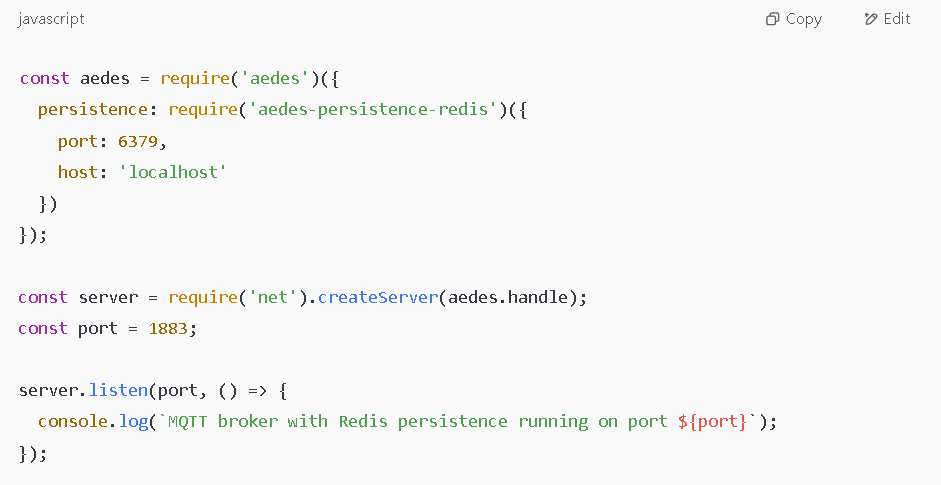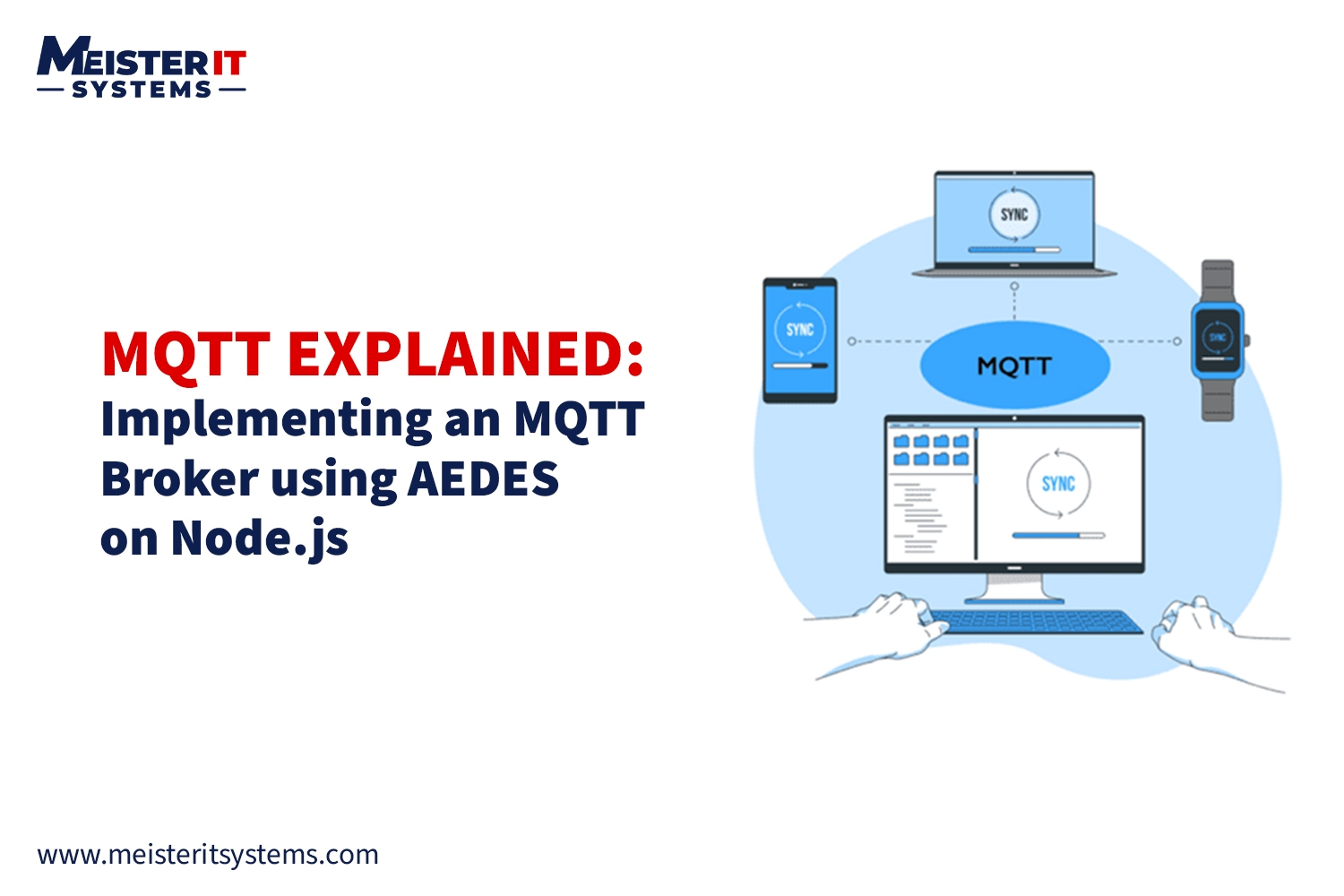Introduction to MQTT
According to a 2021 study by IoT Analytics, over 70% of IoT platforms support MQTT, making it the dominant protocol for IoT communication.
MQTT (Message Queuing Telemetry Transport) is a lightweight, publish-subscribe network protocol. It is designed for constrained devices and low-bandwidth, high-latency environments. It was developed in 1999 by Andy Stanford-Clark of IBM and Arlen Nipper of Arcom. The primary goal was to create a protocol that is simple, efficient, and suitable for machine-to-machine (M2M) communication and the Internet of Things (IoT).
Today, MQTT is widely used in IoT applications due to its efficiency, reliability, and scalability. As a service provider, implementing an MQTT broker is essential for building robust IoT solutions.
In this guide, we will walk you through setting up an MQTT broker using Aedes on Node.js, enabling efficient communication for your IoT applications.
Key Features of MQTT
Understanding the features of MQTT is crucial for effectively implementing it in IoT applications. Whether you're developing a smart home system, an industrial automation solution, or a large-scale IoT network, knowing these capabilities will help you make better choices for a smooth setup.
Here are the key features that make MQTT a powerful communication protocol:
1. Lightweight and Optimized for IoT
MQTT is designed to minimize data overhead, making it ideal for devices with limited processing power, memory, and bandwidth. This allows small sensors and embedded systems to communicate efficiently, even over unreliable networks.
2. Quality of Service (QoS) for Reliable Messaging
MQTT provides three levels of message delivery assurance:
- QoS 0 (At most once): The message is sent without confirmation, best for non-critical updates.
- QoS 1 (At least once): Guarantees delivery but may result in duplicates.
- QoS 2 (Exactly once): Ensures a message is delivered only once, making it the most reliable option.
3. Retained Messages for Instant Updates
The broker can store the last message sent on a topic. When a new subscriber joins, it immediately receives the latest update instead of waiting for the next published message. This ensures important data, like sensor readings or device statuses, are not missed.
4. Last Will and Testament (LWT) for Failure Detection
If a device disconnects unexpectedly, MQTT can automatically send a predefined "last will" message to inform other clients. This helps monitor device availability and take necessary actions in case of failures.
5. Persistent Sessions for Unstable Connections
Devices in IoT environments may lose connectivity frequently. MQTT supports persistent sessions, allowing clients to reconnect without resubscribing, ensuring uninterrupted data flow even in challenging network conditions.
6. Topic-Based Messaging for Efficient Communication
Instead of direct device-to-device communication, MQTT uses a hierarchical topic structure. This enables targeted messaging where subscribers receive only relevant data, reducing unnecessary network traffic and improving scalability.
7. Security and Authentication for Safe Data Exchange
MQTT supports authentication through usernames, passwords, and token-based access control. It also allows data encryption using Transport Layer Security (TLS), preventing unauthorized access and ensuring secure communication.
By leveraging these features, MQTT provides a reliable and efficient messaging solution tailored for IoT applications, enabling seamless integration of connected devices across industries.
How MQTT Works?
MQTT operates on a publish-subscribe model, where communication flows through a central broker rather than direct client-to-client messaging. This model enhances efficiency, scalability, and reliability, making it ideal for IoT applications.
Key Components of MQTT:
- Publisher: A device or application that sends messages to a specific topic.
- Broker: The central server that receives messages from publishers and routes them to the appropriate subscribers.
- Subscriber: A device or application subscribing to a topic to receive relevant messages.
Message Flow in MQTT:
- A Publisher sends a message to a predefined topic (e.g., sensor/temperature).
- The Broker receives the message and checks which clients have subscribed to the topic.
- The broker forwards the message to all subscribers of that topic.
Since clients do not need to know each other’s details, this separate communication is very efficient for IoT networks. In IoT networks, devices frequently disconnect and reconnect due to unstable connections or limited power.
Why Choose Aedes for Your IoT Broker?
Now that we've explored MQTT's key functionalities, let’s discuss why Aedes is a preferred broker for IoT solutions.
The broker plays a crucial role in ensuring efficient message distribution and seamless communication between devices. While there are several MQTT brokers available, choosing the right one depends on factors like performance, scalability, and ease of integration.
Traditional brokers like Mosquitto and EMQX are widely used, but for developers seeking flexibility and direct integration with their Node.js applications, Aedes stands out as a powerful choice. Aedes is a lightweight, high-performance MQTT broker designed to be embeddable and customizable, making it an excellent option for IoT applications that require tailored solutions.
By understanding how Aedes enhances MQTT communication, you can leverage its capabilities to build efficient, scalable, and secure IoT systems.
Features of Aedes as IoT Broker
If you are looking for a high-performance, flexible, and scalable MQTT broker for your IoT applications, Aedes delivers exactly that!
Aedes is optimized for speed and seamless Node.js integration, making IoT communication management effortless.
Here’s what makes it stand out:
1. High Performance for Large-Scale IoT
Aedes is optimized for handling thousands of concurrent connections with minimal resource usage. Its event-driven architecture ensures efficient message processing, making it ideal for high-traffic IoT networks.
2. Extensibility with Custom Plugins
Aedes provides hooks and a plugin system that allows developers to extend its functionality. Whether you need custom authentication, logging, or message filtering, Aedes can be tailored to meet your application's unique needs.
3. Broad Compatibility with MQTT Standards
Aedes supports multiple versions of MQTT, including v3.1, v3.1.1, and v5.0, ensuring seamless communication with various MQTT clients and platforms. This makes it easier to integrate with existing IoT infrastructures.
4. Scalable and Fault-Tolerant Architecture
For applications requiring high availability and load balancing, Aedes supports horizontal scaling through clustering. This ensures reliability and consistent performance as the number of connected devices grows.
By leveraging Aedes, developers can build custom, scalable, and high-performing MQTT solutions, making it a powerful alternative to traditional brokers.
Also read: How To Process Images With sharp in Node.js?
Setting Up an MQTT Broker Using Aedes on Node.js
Setting up an MQTT broker with Aedes is straightforward. Follow these steps to get your broker running smoothly.
Prerequisites
Before setting up an Aedes MQTT broker, ensure that you have the following installed:
- Node.js
- npm (Node Package Manager)
Step 1: Install Aedes
Open your terminal and run the following command:

Step 2: Create a Basic MQTT Broker
1. Create a new file named mqtt_broker.js.
2. Add the following code:

Step 3: Run the Broker
To start the MQTT broker, run this command in your terminal:

If successful, you should see:

Step 4: Connect MQTT Clients
To test the broker, you can use clients like MQTT Explorer, Mosquitto, or MQTT.js.
Install MQTT.js
Run the following command to install MQTT.js:

Create a Client Example
1. Create a new file named mqtt_client.js.
2. Add the following code:

3. Run the client script:

Advanced Features of Aedes
Aedes offers powerful features for better control, performance, and monitoring.
Authentication and Authorization
Aedes allows you to add authentication and authorization to control client access.
Persistent Storage with Redis
To store messages persistently, integrate Aedes with Redis:

Modify your broker code as follows:

Cluster Mode for High Availability
Aedes supports clustering to distribute client connections across multiple broker instances. This enhances performance and fault tolerance.
Custom Hooks for Custom Logic
Developers can define custom hooks to trigger specific actions on client connection, message publishing, or subscriptions.
Monitoring and Debugging
For improved visibility, consider:
- MQTT Explorer to monitor broker activity.
- Enabling logging in Aedes to track detailed broker operations.
By following these steps, you can successfully set up an MQTT broker using Aedes and enhance it with powerful features for better performance and control.
Also read: Step-By-Step Guide To Set Up NodeJS Backend Server on Ubuntu 24.04
Use Cases of MQTT and Aedes
Here are some practical examples of how MQTT and Aedes are used in different domains:
1. IoT Device Communication
A connected healthcare system uses MQTT to transmit real-time patient vitals, such as heart rate and oxygen levels, to a hospital's monitoring dashboard, allowing doctors to track patient health remotely.
Example: A wearable health device uses MQTT to send heart rate and oxygen level data to a mobile app, enabling users to monitor their health in real time.
2. Home Automation Systems
Aedes enables smart home devices like lights, thermostats, and security cameras to communicate instantly via MQTT.
Example: Aedes can be used in a smart home setup where lights, thermostats, and security cameras communicate instantly via MQTT, enabling automation based on user preferences.
3. Real-time Data Streaming
Enable continuous data flow in industrial applications for better monitoring and decision-making.
Example: A factory uses MQTT to stream real-time data from conveyor belts and sensors to a cloud-based system, allowing managers to monitor performance and detect failures early.
4. Industrial Automation
Enhance machine-to-machine communication to optimize industrial processes and performance.
Example: In an oil refinery, MQTT enables real-time communication between pumps, pressure sensors, and control units, ensuring smooth operations and reducing downtime.
Conclusion
MQTT is a robust protocol for IoT, and Aedes offers a lightweight, scalable MQTT broker solution. It ensures efficient, real-time messaging for IoT, home automation, and industrial applications. By leveraging Aedes, businesses can enhance communication, security, and scalability.
Looking to implement a scalable MQTT broker? MeisterIT Systems provides expert IoT solutions to help you achieve seamless integration.
Contact us today!
